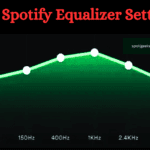If you use Spotify, you’ve probably noticed how important color is in its design. The colors make the app look great and are a big part of the overall experience. Colors create a visual identity and enhance our overall user experience. Here’s a guide to the different colors used across the platform so you can get some insight into why your favorite app looks the way it does.
Short Answer
Spotify’s branding has a distinct color scheme with Spotify Green (#1DB954) featured as the first color. It is accompanied by secondary colors which include charcoal, white, dark brown, light gray. The color palette is modern and gives Spotify a consistent, stylish look. Initially, Spotify used a more vibrant fluorescent green color. However, it was then changed to the present green color for a better and more attractive appeal to the customers. This article provides insight into the use of these colors in design as well as their psychological effects.
Table of Contents
Overview of Spotify Color Palette
What is Spotify’s correct color palette? Spotify has a color scheme that reflects the brand’s modern and dynamic personality. Take a look at primary colors and secondary colors:
Primary colors:
- Spotify Green: #1DB954
Secondary Colours:
- White: #FFFFFF (RGB: 255, 255, 255)
- Black: #191414 (RGB: 25, 20, 20)
- Charcoal: #212121 (RGB: 33, 33, 33)
- Grey: #535353 (RGB: 83, 83, 83)
- Light Grey: #B3B3B3 RGB: 179 179 179.
The colors create the sleek, cohesive look that Spotify is known for.
The Evolution of Spotify Color Palette
Did you know that Spotify’s color palette didn’t always look the same as it does now? When Spotify first started, its colors looked a bit different. Over time, Spotify has changed its colors to match the brand’s growth and evolution.
Spotify started with a neon green that was brighter. As the platform matured they changed to a subdued but still vibrant green (#1DB954) to match the professional and user-friendly look. This made the brand look both sophisticated and approachable.
What is the Spotify Color Palette?
Spotify uses a mix of bright, bold colors and softer shades in its color palette. This range of colors helps create a unique look that differentiates Spotify from other streaming services. The main colors Spotify uses are black, gray, green, and blue. They use these colors in different ways to highlight various parts of the app.
- Black – Black is used to create a modern, sleek look throughout the app. It is used in the navigation bar, logo and many other parts of the platform.
- Gray – Gray is used to add subtlety to the design. It is used in key areas, such as artist pages, search bars, and many other platform components.
- Green – Green is a bold color that really pops in the design. It highlights important features like playlists and podcasts and gives the album a unique look.
- Blue – Blue is a calming yet energetic color. It is used in many areas of design, from sidebars to music controls. It is also an accent color for various components such as buttons and progress bars.
The Spotify color palette consists of these four main colors plus some accent colors such as yellow, purple and red. These accent colors are used sparingly but help give Spotify a unique look that stands out. When songs match Spotify’s color palette, it creates a memorable visual experience for users. A personalized color palette makes the app enjoyable for everyone. When your Spotify account is personalized, it creates an even more integrated experience with the platform.
Spotify Colors: A Detailed Analysis
Check out the colors Spotify uses in its palette.
Spotify Green (#1DB954, RAL: 29, 185 84)
- Usage: This is the cornerstone of Spotify’s brand. It is used in logos and app icons.
- Green represents progress, innovation and freshness. It’s perfect for a platform that’s always changing and growing.
White (#FFFFFF RGB: 255 255 255)
- Use: Used as a background to create a space that is clean and clear, allowing other elements to stand out.
- White is a good contrast and balanced color that makes it easy to navigate.
Black (#191414 – RGB: 25, 20, 10):
- Use: Text and background can be used to create a sleek modern look.
- Black is a sophisticated and elegant color that ensures readability.
Charcoal (#212121; RGB: 33 33 33)
- Use: Adds depth to the interface, typically used in footers and sidebars.
- Charcoal is a neutral yet strong color that adds strength to any color scheme.
Grey color (#535353 RGB: 83 83 83) and Light Grey color #B3B3B3 RGB: 175, 179, 194:
- Use: Secondary text, icons and backgrounds.
- Grays are key to maintaining a minimal, uncluttered look.
How Does it Work?

The tool will give you a set of colors based on what you listen to. Four possible outcomes can be achieved:
- Red Palette You hear a lot of upbeat songs.
- Pastel Color Palette You hear mostly upbeat and danceable songs.
- Palate Palate: You listen to a lot of happy and upbeat songs (high valence).
- Orange Palette You hear mostly danceable songs.
Color Palettes: Different Types

Understanding the color palette will help you better understand Spotify’s choices, and how similar strategies can be applied to your design. Here are some examples of typical color palettes.
1. Monochromatic Palette
A monochromatic palette uses different shades, tones, and tints of a single color. This makes the design look unified and balanced, which is great for creating a stylish appearance.
Example:
- A palette with different shades of green ranging from light mint to forest green.
2. Analogous Palette
A color palette that is uniform is made up of the colors next to each other on the color wheel. This color scheme is nice to look at and reminds us of nature.
Example:
- Colors like blue, blue-green and green.
3. Complementary Palette
Complementary colors on the color wheel are located opposite each other. This palette is perfect for creating high contrast and dynamic looks.
Example:
- Pair blue with orange or red with green.
4. Triadic Palette
Triadic color palettes use three colors that are evenly distributed around the color wheel. This creates a vibrant and balanced color scheme.
Example:
- Red, yellow and blue combined.
5. Tetradic Palette (Double Complementary)
This palette consists of four shades, two complementary Paris. This palette is perfect for creating colorful, rich designs.
Example:
- Use red, green, orange and blue together.
6. Split-Complementary Palette
Split-complementary palettes use one primary color, and two colors that are adjacent to the complementary color. This type provides high contrast without the strain that comes with a complementary color palette.
Example:
- Yellow-orange, red-orange and blue as a base with orange accents
Use these palettes to match Spotify’s colors
Spotify uses a monochromatic color palette centered around its signature green. It also uses a complementary color scheme, balancing vibrant greens with neutrals like black, gray and white. This combination highlights the green color without being overpowering, while maintaining a modern and clean aesthetic.
Example:
- Spotify Green (#1DB954) combined with Black (#191414) and White (#FFFFFF), creates a sleek and professional look.
The Psychology of Spotify Colors
Colors don’t just look good, they can evoke feelings and emotions. Spotify’s colors are a powerful tool.
- Green: Promotes relaxation and creativity, improves user experience.
- White: This color promotes clarity and simplicity. This makes the app more user friendly.
- Black & Charcoal – Adds a professional and sleek look to the app, giving it a premium feel.
- Grey: This neutral color gives the design a modern look. It also allows basic elements to stand out more.
Application of Design
You can use Spotify’s color palette in your design. You can use these hints to make your own set of colors.
- Basic Use: Use Spotify Green to highlight buttons, focal points and highlights.
- Contrast green and white or black to bring out the best in your elements.
- Use a gray or charcoal background to make the interface readable.
- Text: Use black or dark gray for text to make it easier to read.
Here are some practical examples:
- Website Design: Use Spotify Green for buttons that call to action against a gray or white background.
- App Design: Use a black background or charcoal with green accents to create a sleek, modern look.
Tools and Resources
Here are some resources and tools to help you in your design process:
- Adobe Color: Create color palettes and save them.
- Color: Explore palettes and create color schemes.
- Canva: Create designs with preset color templates.
- Spotify Brand Assets: Access official logos, guidelines and more on brand pages.
How to Create Spotify Color Palette
Now that you know the benefits of using the Spotify Color Palette, let’s see how you can create your own palette for your next project.
Choose a Primary Color
Your primary color should be the one that stands out the most and is usually used as an accent or accent color in the design. A good way to begin is by choosing one of the eight colors from Spotify’s official palette. Usually, a musical color palette includes two main colors along with a few accent colors. Assuming you choose purple as the base color, you can continue with the next steps. Even if you don’t pick a color from the official palette, make sure it’s not too close to any of Spotify’s colors.
Choose a Secondary Color
Your second color will bring contrast and make your design more interesting. It should be visually different from your base color. For example, if you’ve chosen purple as your primary color, consider using a light blue or green as a secondary color. While you don’t want the colors to look bad together, remember that you do want them to look different from each other.
Choose Accent Colors
You can choose two-tone colors from Spotify’s official palette or use your own shades if needed. Use these shades carefully and only when you really need them because they can quickly take over a design. In the case of purple, gold and navy can serve as excellent accent colors as primary and secondary colors. Alternatively, if you prefer a softer appearance, think about using gray or light pink as your accent colors.
Use Gradients
Spotify likes to use gradients to make their designs look deeper and more textured. To make a gradient with the Spotify palette, choose two shades from the same color group and put them in a line or circle pattern. This makes a gentle change between colors that makes your design more interesting without making the other colors clash. Here are some different gradients you can try with the Spotify palette:
- Purple and Blue: When used together, these colors create an ethereal, ethereal look and feel. Just like when you gaze at the night sky.
- Gold and Purple: This color combination is perfect for a luxurious, glamorous look. It is great for designs that need to create a sense of richness and luxury.
- Green and Purple: It’s a fantastic method for achieving an organic, natural vibe. This is especially useful if you’re trying to convey the idea of growth or renewal in your design.

Use Your Palette
Now that you have your colors picked out, it’s time to use them in your designs. You can use color for backgrounds, typography, UI elements, and more. Remember that you don’t have to use all the colors every time – instead, pick and choose the ones that work best for your project. Here are some great ways to use your Spotify color palette:
- Create an attractive homepage using bright, vibrant colors.
- Try using gentle gradients as backgrounds for product pages or landing pages.
- Add a little flair and personality to your app with simple UI elements in different shades.
- Highlight typography with contrasting colors.
- Use color to draw attention and create a visual hierarchy in your design.
Creating a cohesive color palette can seem overwhelming at first, but with some practice, you’ll easily create beautiful designs that capture the spirit of Spotify. You can create stunning visuals to highlight your projects with just a few clicks.

What are the benefits of the Spotify color palette?
Let’s take a look at some of the benefits of using the Spotify color palette.
Creates an instantly recognizable visual identity.
When you use the Spotify color palette, your visuals will have a unique look that people can easily recognize. This helps build brand recognition and makes it easier for consumers to recognize your brand in a sea of other brands. A personalized color palette based on the Spotify color palette helps strengthen your brand identity and make it stand out from the crowd. Just as user data accessible through Spotify helps provide insight into consumer preferences, so does a well-designed color palette. A cultural database that uses the Spotify color palette can help identify trends and gain insight into what appeals to your customers. Just as Spotify’s logo is recognizable and instantly associated with the brand, it can unify all aspects of your branding in a visually distinct way.
Increases the visibility of your brand
The Spotify color palette features lively, vibrant colors that are bound to grab attention. When you use these colors in your visuals, they will definitely grab attention. By using this unique color palette, your visuals will stand out, and it helps customers recognize and remember your brand faster. Let’s say you’re running an online campaign. Using these colors will make sure your pictures catch more eyes and stand out compared to using regular colors. Because it creates beautiful images and visuals, consumers will want to interact with your brand.
Improves customer experience
The Spotify color palette helps create an immersive and engaging user experience for users. For example, users will be drawn to visual images when they try to find something on a website or app because of their appealing colors. This makes it easier for customers to find what they need faster and improves their overall customer experience. Plus, songs inspired by colors set a special and unforgettable mood for users. Colors that influence consumers’ listening habits create a highly personalized experience. And considering users’ musical preferences makes the experience even better, adding to the enjoyment.
Enhances visual storytelling
The Spotify color palette is also fantastic for visually narrating stories. It can assist you in expressing significance and emotion through your visuals, in a way that words alone cannot achieve. Vibrant colors draw attention to key elements of the story, making it easier for viewers or users to understand and remember the story. Just as a pastel palette can be used for a calm, peaceful look and feel, the Spotify color palette can create exciting styles that evoke emotion. Just like the red palette, it can symbolize danger or excitement. When consumers’ music preferences shift, the color palette can convey the emotion or message of that change.
Reflects the personality of your name
This unique selection of colors empowers you to infuse character into your visual designs. This helps consumers associate colors with your brand and identify it easily. It also makes visuals more engaging and memorable, leading to greater user engagement. If you’re trying to create a unique and recognizable brand identity, the Spotify color palette is a great choice.
FAQs:
Conclusion
The Spotify Color Palette is like a cool kit for making art or digital stuff. If you learn how each color goes with the others, you can make really awesome designs that catch attention. But remember, these colors aren’t just for everything — you gotta use them right! Every project and audience is different, so it’s important to experiment and find the right color combination that works for you. With the Spotify color palette, it will be very easy to create attractive and eye-catching designs.
Must Read: Get Spotify Redeem Gift Card in Simple Steps



